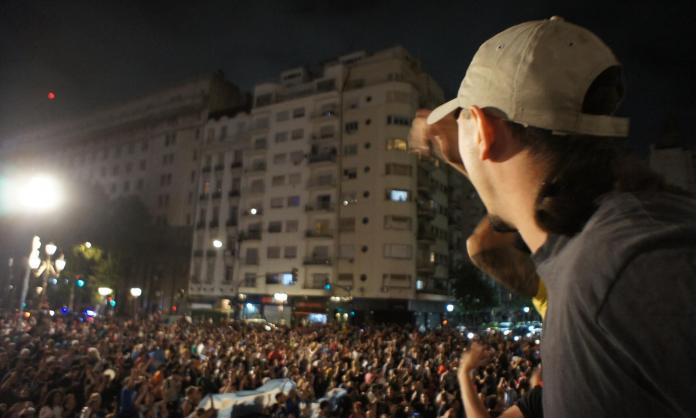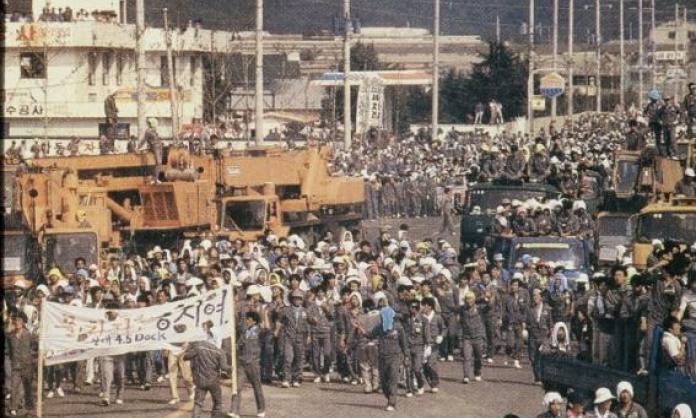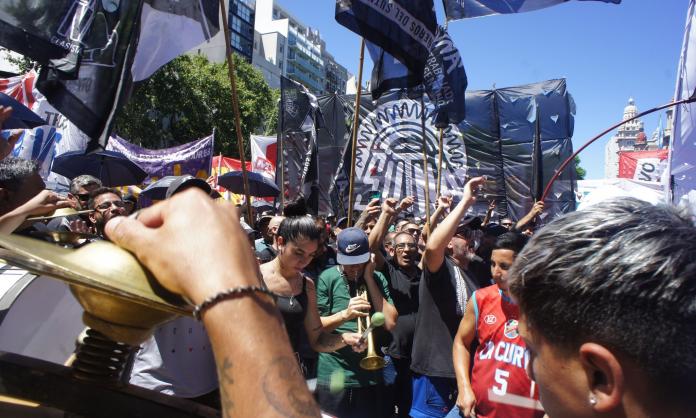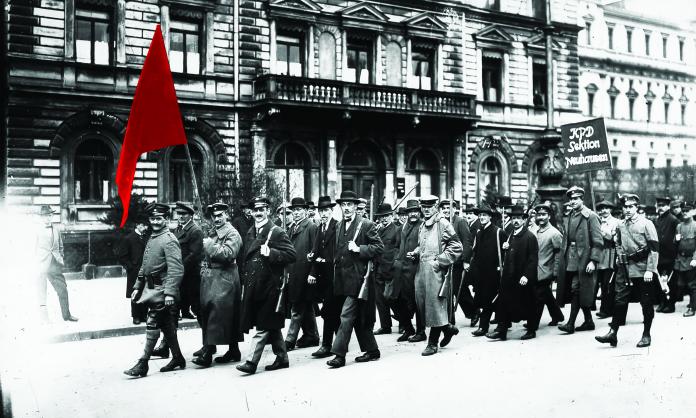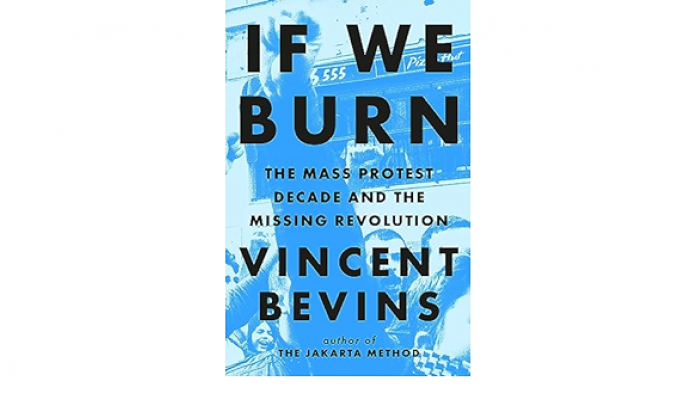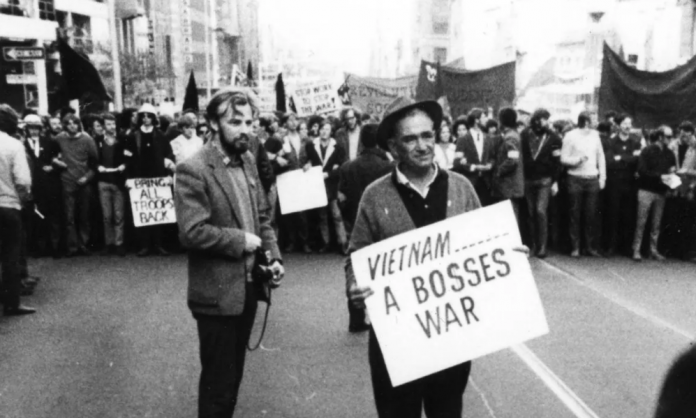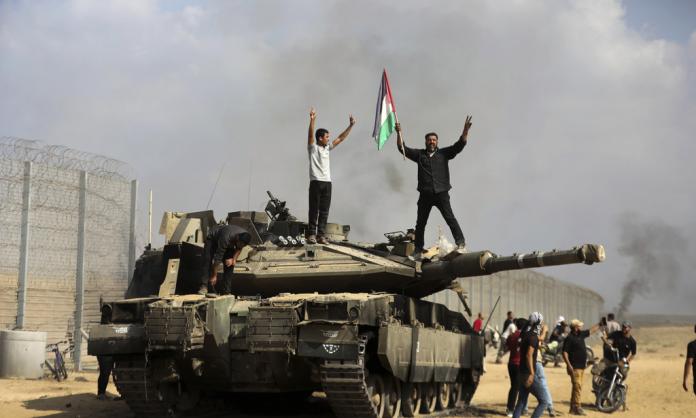As midnight approached on 20 December, people streamed from their homes into streets across Argentina, banging pots and pans. As small, scattered groups marched, they grew and merged, forming cacerolazo demonstrations in neighbourhood after neighbourhood. (Cacerolazo is derived from “casserole dish”, which middle-class people traditionally bang with spoons in Argentinian protests.) Javier Milei, the newly elected far-right president had appeared on television just minutes before to announce a package of sweeping spending cuts and price increases.
In one neighbourhood in central Buenos Aires, the capital, hundreds of protesters blocked the streets and marched towards the Congress building. Amid the cacerolazo cacophony, voices sang out: “La patria no se vende!” (“The homeland is not for sale!”). As they approached the Congress, many started to run, blocking intersections. The march grew and grew as protesters argued with onlookers to join the procession.
Reaching the Congress, this cacerolazo converged with others from across the city. The area now a massive sea of people, a song began to echo: “Paro, paro, paro – paro generale!” (“Strike, strike, strike – general strike!”). The night was filled with anti-Milei chants, calls for workers’ unity and football songs attacking politicians. A popular chant highlighted the absence of the major trade union federation, the General Confederation of Labour: “Where is it, we can’t see it, the famous CGT?”
Left politics in Argentina is shaped by the Trotskyists and the Peronists. Peronism is a mass political movement that has taken the place of traditional social democracy, the origins of which are in the governments of Juan Péron in the mid-twentieth century. Today, the main organisational expression of Peronism is the Justicialist Party, but it exists as a broader movement; most of the union bureaucracy is Peronist.
Young socialists from the Movement of Socialist Workers and the Workers’ Party held their groups’ newspapers like flags along the fence outside the Congress. Within hours, tens to hundreds of thousands of people were gathered. They stayed until the early hours of the morning. Similar protests took place around the country, from the provinces to the cities of Rosario, Mar del Plata and Córdoba.
Days later, everyone is talking about a general strike. Socialists, including the Movement of Socialist Workers, are pushing for one to be called, and workers are putting pressure on the union leaders. The CGT has partially conceded by calling an all-in union demonstration for Wednesday 27 December at noon. A general strike could be called the following week. On 21 December, hundreds of nurses marched through the capital and tyre workers gathered at Congress, both calling for a general strike. On 22 December, thousands of unemployed workers marched to the centre of the city with the same demand. Later the same day, thousands of state employees marched. Cacerolazo protests have continued across the country every night since, though in smaller numbers.
Argentinians are infuriated by Milei’s proposed economic shock therapy. The austerity package was passed by decree, flouting normal congressional procedures and making a mockery of the parliamentary democracy that was won just 40 years ago after the toppling of a right-wing dictatorship. The word “memory” is raised everywhere: the memory of the dictatorship; the memory of the mass movement against it; and the memory of mass mobilisations across the country in the early 2000s against economic mismanagement and austerity. The memories are seared into the political consciousness of older workers. They understand what an attack looks like and know how to fight.
And this is a serious attack. The privatisation of public companies, deregulation of the residential rental market, reductions in redundancy payments, giving bosses more power to fire employees, attacks on health care, education and pensions, and more. To pay down the country’s US$43 billion debt to the International Monetary Fund, Milei is taking a chainsaw to every pillar of support for working-class living standards.
The attack comes in the context of mass poverty (the rate is 40 percent, according to the government’s statistics agency), low wages (the minimum is just $215 per month) and an inflation rate of 160 percent. Many workers here relate that most people, if they can get work, have to hold several jobs to make ends meet. And more than one-third of workers are in the so-called underground economy, according to official statistics. That is, they don’t receive pension contributions or health insurance. There is also a significant layer of permanently unemployed people who are forced to make do with the meagre supplements provided through the underfunded welfare system.
Peronist and centre right-governments have forced through austerity in exchange for international loans to fund the government in recent years.
But this new round of cuts is the worst so far. Prior to his announcement, Milei and Security Minister Patricia Bullrich established the so-called protocolo anti-piquete, an anti-picket law banning protesters from blocking streets. It was followed by threats of police repression, and a promise to make protesting organisations pay for the cost of policing. That is, to pay the wages of the people sent to arrest them.
Late on 20 December, Lu, a young member of the Movement of Socialist Workers, stood gripping the fence of Congress and grinning out at the crowd. “The people are in the streets against this new proposal”, she told Red Flag as she waved to the masses of people below. “We’re in the streets against anything that stops us from living a proper human life. It’s amazing. It’s just like 2001. We’re again in the streets singing, ‘The people united will never be defeated!’”
2001 was marked by severe economic crisis and a series of revolts and strikes that brought down successive governments, culminating in the so-called Argentinazo protests and riots in December. Many companies were also put under workers’ control in this period, as bosses fled the country or refused to allow production to continue.
“Milei’s election was the reaction to a very bad Peronist government and a very bad inflation crisis”, 24-year-old Elena said during the smaller cacerolazo march from the middle-class neighbourhoods to the Congress. “People didn’t know what they were voting for. He promised on the campaign trail that the political class would pay for the crisis. People didn’t know that their pensions would suffer, that the bus fare might triple and so on. But now they understand. We’re showing we’re not going to take it.”
Part of the significance of the spontaneous night march was that it broke the anti-picket law for the second time. The first occurred earlier the same day. Hours before Milei’s austerity announcement, the left held a mass demonstration to mark the anniversary of the Argentinazo and to stand against Milei’s policies.
In an attempt to generate support for the protest ban and hostility to the left, the government used billboards, and announcements in train stations, to warn people not to go to the rally and asking citizens to call a hotline if they were forced against their will to attend. The National Gendarmerie, a quasi-military force that guards border regions, was deployed the same day to help police cut off a similar demonstration in Neuquén, a small city in the west of the country.
Yet, despite all the intimidation and propaganda, the afternoon protest at Plaza de Mayo in Buenos Aires was huge, bringing together the major socialist parties, militant union groups, piqueteros (the name given to groups who block streets during protests to highlight particular issues) and other social movements. Ámbito Financiero, an Argentine newspaper, reported that Security Minister Patricia Bullrich estimated the crowd at 20,000 and 50,000 people. It was likely bigger. Police made only feeble attempts to prevent the protesters from getting onto the road. So when Milei’s austerity announcement came later, people already knew that the protest ban could be challenged.
The government has announced that it will charge fourteen organisations involved in the daytime demonstration $60,000 to pay for the police presence. This farcical attack on the left indicates that the government hasn’t totally backed down. But, unlike in smaller cities, it can’t prevent the mass demonstrations in Buenos Aires without risking a political crisis.
There is a serious fight now on. On one side is the far-right government. On the other is the huge, diverse set of far-left organisations and institutions alongside masses of unorganised but very angry people. What will happen next? It’s impossible to say. But if the union leaders refuse to call a general strike, the government will have the advantage.




